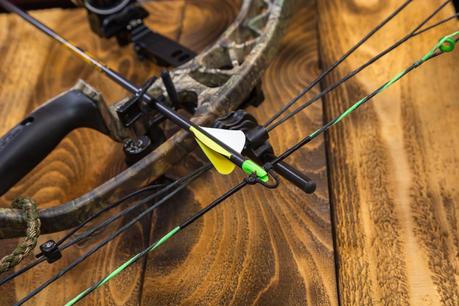 With compound bow ownership comes the need for periodic bow maintenance. Like any piece of precision equipment, you should inspect a compound bow from time to time, and typical wear items need replacing. Your bow string in particular requires a bit of attention. Despite wishing otherwise, bowstrings can and do wear out, needing eventual replacing.
With compound bow ownership comes the need for periodic bow maintenance. Like any piece of precision equipment, you should inspect a compound bow from time to time, and typical wear items need replacing. Your bow string in particular requires a bit of attention. Despite wishing otherwise, bowstrings can and do wear out, needing eventual replacing.
When a bowstring begins to age, and signs of fraying become evident, it’s decision time. Do you apply an ample amount of bowstring wax and ignore the issue at hand? Or should you get ahead of the problem and change your bow’s string to ease the risk of possible failure? While a certain amount of string wear is fine, a badly worn or frayed bow string can be a hazard to your safety and your bow’s structural integrity. You should not ignore it.
While many archers choose to have their bows restrung at their nearest archery shop, others prefer to take matters into their own hands. Have you ever considered replacing your own bowstring, but are unsure where to begin or how to proceed? If so, the following steps will help you tackle this task head-on.
Things To Know
Before you tackle restringing your own compound bow, there are several factors of relevance which one must keep in mind. Many of these factors pertain to keeping yourself and your bow out of harm’s way during the stringing process.
Just Because You Can, Does Not Mean You Should
There are several ways to go about installing a new bow string on your compound bow. However, you must carefully select a method that minimizes the risk of harm to yourself or your bow. When it comes to maintaining a compound bow, not all advice is good. It pays to remember that a compound bow is a precision instrument. You can damage it if you’re not careful.
While some archers release the tension on their bow’s strings and cables by sticking an Allen wrench in a bow’s actuated cam, we advise against it. This is known as “scotching” a bow’s cam against its corresponding limb. It not only risks damage to the bow’s limbs and cams, but can be a hazard to your safety, should this tool become dislodged while under pressure.
Archery shops use a bow press to relieve the pressure from a bow’s limbs and cams. In reality, most individuals don’t have a bow press at the ready in their garage, and purchasing a press can cost several hundred dollars. However, the best compromise is to keep a portable, cable style bow press on hand. You can buy one for $40 to $50 and they’re the perfect tool for DIY bow technicians.
Look Before You Leap
If you haven’t restrung a compound bow before, a bit of confusion is common when it comes to a bow’s string and buss cable route. While this in itself can be frustrating, most archers carry the most potent tool for avoiding such issues in their pockets.
In today’s modern age, few go very far without having their cell phones at the ready. The beauty of this is that most modern smartphones can take crystal clear photographs. Before releasing tension from your bow’s limbs and cams, snap a series of photos from various angles. These photos will capture every inch of your bow’s old string and control cable set.
These photos will serve as reference, should you run into difficulty remembering your bow’s string and cable routing. In this case, a picture truly is worth a thousand words. A quick glance at these photos when in a bind can prevent damage from inadvertent misrouting issues.
A Word On String Selection
You can’t make the wrong bowstring work. This is why it’s crucial that you only order new bow strings and cables from reputable dealers. They can assist in determining which string or cable to buy.
When ordering new strings, many options exist. This is especially true when it comes to the variety of string materials available. Custom bowstrings come in many compositions, colors, and string lengths. Reputable bowstring manufacturers can help you navigate the options and proper fitment.
When placing a bowstring order, make sure that you have the exact make and model of your bow on hand. Most manufacturers will ask for this information, as they can reference the stock string lengths for your bow. You’ll then have a list of compatible products to choose from.
How To String A Compound Bow
The following steps will help you through the process of replacing your compound bow’s strings and cables. This process uses a portable, cable-style bow press. You can buy these presses from many retailers for just a few bucks. A portable press eliminates some of the risk of restringing, keeping you safe.
1. Study the Cable Routing
Any time you’re restringing a bow, it’s a great idea to study the fine details associated with string and cable routing. Remember, don’t assume that you’ll be able to determine the details of such routing easily. That mindset can lead to trouble, as we all make mistakes from time to time.
There are many ways of recording this routing for later reference. You can take photos of your bow’s cables and strings, sketch out a quick diagram, or take shorthand notes. This step will save trouble during the reinstallation process. This is also a good time to measure the distance between the D-loop and peep sight on your current bowstring. These measurements allow you to replicate your prior setup.
2. Reduce Poundage
After you record the string and cable routing, reduce your draw weight poundage. Do this before attaching the cable press’ leads. While many bypass this step, it can save undue stress to your bow’s limbs during the compression process.
To reduce your bow’s draw weight, turn the limb bolts found at each limb’s junction point with the bow’s riser in a counter-clockwise fashion. The amount that each bolt turns should remain consistent from one limb to the next. As a general rule, each limb bolt should turn approximately 2-3 full turns.
3. Attach the Press Cables
At this point, you’ll attach the cables of your portable bow press to your bow’s limbs. Each portable cable-style press differs in design, but the setup is mostly the same.
This style uses a cable that runs through two rollers, with a bolt that pulls tension on the cable at its central-most point. When tightened, this bolt shortens the overall length. The cable extends from each end of the tensioning mechanism, with these ends attaching to each of the bow’s two limbs.
Depending upon the style of your bow’s limbs, you’ll use the press’ L-shaped adaptors or standard T-shaped ends to gain a secure grasp. The L-shaped brackets cup the end of a bow’s limbs, while the T-shaped ends that are part of the press, slide into the void between each half of a bow’s split limbs.
Once in place, the press’ tensioner bolt tightens to put slack in the bow’s string and cables. For a visual demonstration of portable bow press setup, check out this quick video:
4. Remove the Old Bowstring
With your bow pressed to the point of relieving tension on its strings and cables, it will now be time to remove your old bow string. Begin by carefully sliding the bow string’s end loop off of its post on the bottom cam. This post is what secures the bowstring in place while under tension. Next, remove the bowstring from the groove or track it rides in on the cam.
You should now find that one end of the bowstring is free. Route this free end up and over your bow’s top cam, or idler in the case of single-cam bows. Next, pop the bowstring out of its groove within the cable slide, and remove its far end from the corresponding post on the bow’s bottom cam.
5. Install New String
With your old bowstring out of the way, you can now begin installing its replacement. Start by sliding the strings end loop over its retention post on the cam. After doing so, ensure the string runs through any grooves or tracks in the same manner as before you removed it. Now route the string over your bow’s top cam or idler pulley, through the slide, and onto its opposite post on the bow’s bottom cam.
With your new bowstring in place, refer to the pictures taken before you started. Carefully inspect the string’s routing and fitment. If anything appears out of place, do not proceed until you make the corrections.
6. Replace the Cables
If you intend to replace your bow’s buss cables as well, now will be the time to do so. Removing and replacing these cables is very similar in procedure to bowstring replacement. While some bows feature a single cable, others feature two, as in the case of dual cam bows.
Begin by removing the cables from their posts at the bottom cam and work them free from their groove in the bow’s cable slide.
Once you remove these cables at their opposite end, you can install your new cables.
7. Install the Peep Sight and D-Loop
Before removing your bow from the press, you’ll install your peep sight and D-loop. If you recorded the distance between your peep sight and D-loop before removing your old string, reference them now. If you use a drop away arrow rest, now is also the time to tie in its actuation cord.
When installing your peep sight, avoid using excessive serving string until you’re happy with the sight placement. By leaving a little wiggle room, you can adjust your peep sight if needed.
8. Let the Tension Off of Your Bow. Slowly.
With your string and cables installed, you can begin to let the tension off your bow press. It can be helpful to keep a bit of tension on your bowstring by hand. This tension prevents the string from coming off of its posts as it comes under tension.
With your portable press disengaged, measure to ensure that your bow’s axle-to-axle, draw length, and brace height measurements match the manufacturer’s spec. Concerning dual-cam models, draw your bow while an assistant checks the cam timing. Remove any discrepancies by adding twists to a bow’s buss cables, in a bid to adjust cam timing.
Stringing A Compound Bow FAQ’s
Is Stringing A Traditional Bow Different Than A Compound Bow?
Yes. Stringing a traditional bow, such as a recurve, can be significantly different than stringing a compound bow. In many ways, stringing a traditional bow is much simpler than stringing a compound bow, as it has no cams or idlers.
Do New Bowstrings Stretch?
New bowstrings do indeed stretch. The fibers in a new bowstring lengthen as they break-in. The break-in process of a new bowstring takes somewhere between 50 and 200 shots. You can minimize the break-in with quality, pre-stretched bowstrings.
Don’t worry about this bit of stretch. It doesn’t affect arrow speed or any other performance-related factor.
How Long Does A Bowstring Last?
The answer to this question is situational and can vary . Much of a bowstring’s wear depends on how well you maintain it. It also depends on how frequently you shoot, and what kind of environmental factors the string experiences. If you expose a bowstring to moisture when bow hunting, or you shoot frequently in various forms of competition archery, you’ll speed up string wear.

